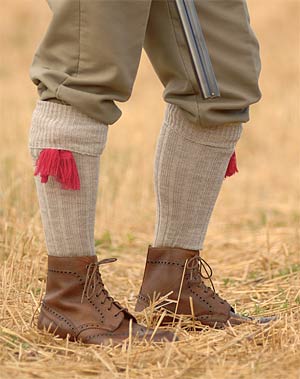| This Week’s Topic… | |||

Best viewed in
|
Kilt Hose Let’s take a step back into history and look at the very first type of kilt hose worn – the cadadh. These hose were cut and sewn from tartan cloth. They were not necessarily the same tartan as the kilt – most often they were a different tartan entirely. In fact, two tone red and white (or red and black, blue and white, and other color combinations) were popular. The important thing here to remember is that these were not knitted hose. They were made from cloth, cut and sewn with the tartan pattern on the bias (diagonal) for elasticity, with a single seam running down the back of the calf and the bottom of the foot. The earliest portrait of anyone wearing the cadadh with a kilt is from the early seventeenth century. Since the earliest evidence we have of anyone wearing any form of kilt (the belted plaid) is from 1594, it would seem that the Highlander has been wearing cadadh for as long as he has been wearing the kilt. Today’s knit tartan hose are the modern descendants of the cadadh. The Hon. Stuart Ruaidri Erskine in 1901, writes: Formerly hose were made of the same stuff with the kilt. Nowadays tartan hose are not worn, save with evening dress, and not always with that…. [after some discussion of the traditional cut and sewn hose] Nowadays, however, hose are invariably knitted, and modern fashion decrees that tartan shall not be donned for day wear. Tartan hose should not be worn for day wear, unless by livery servants, pipers, or some other in “day full dress.” For day wear he prefers simple, plain colored hose, and for evening for formal wear, diced hose of whatever color looks well with the kilt. J. Charles Thompson in “So You’re Going to Wear the Kilt,” writes: Remember… that tartan hose [here he is referring to knit hose] are for evening only! They are not correct for day wear… Diced hose in blue and white or red and white have always been an alternative choice for evening wear, and since even these are hard to come by, you will see many men in evening attire with solid color stockings. The purists have given in on this point, but they insist that the only correct color is white. Bob Martin, author of All About Your Kilt (second edition, 2001). On the subject of hose, he begins:
Not too
much need be said about kilt hose. Some time ago, the only hose “ruled”
proper for evening wear were “tartan” hose, with fold-over or
castellated tops. The “rules” went through a modification, and now white
knitted hose are quite popular. Since when, may I ask, must a color be
apportioned its time of day or night? May not a good, strong red be worn
with equal “correctness” at night? Perhaps one is wearing an all-tartan
evening outfit with no white save a jabot. Wouldn’t hose that tone with
the kilt be preferable to white ones? The books say The truth of the matter is that there are no “rules” about what you wear with your kilt other than the rules of fashion and common sense – but then again, some people have no fashion sense.
|
||
